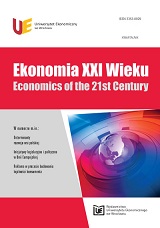Determinanty rozwoju wsi polskiej na początku XXI wieku
Determinants of Polish rural development at the beginning of the XXI century
Author(s): Franciszek KapustaSubject(s): Economy
Published by: Wydawnictwo Uniwersytetu Ekonomicznego we Wrocławiu
Keywords: countryside; areas; co-financing; support; infrastructure; multi-functionality
Summary/Abstract: Countryside, as an area and place of living of the increasing number of people undergoes numerous changes, including: the reduction of the area of countryside, the increase of the number of rural population and the level of infrastructure, the deepening of diversification of activity and of main sources of living of the population. These processes take place under the influence of internal (domestic) and external factors. The European Union supports activation and renewal of rural areas. For the years 2007- -2013 there was developed the program which became a design supporting four priority axes. The first axis is of a commercial nature and its aim is to improve the competitiveness of the agricultural and forestry sector. The second axis is associated with ecological and environmental considerations and focuses on the improvement of environment. The third axis contains social values and directs efforts to improve the quality of life of population in rural areas and at the same time aspirations to diversify the rural economy. The fourth axis applies to local community. The program defines the scope and forms of rural support for the years 2007-2013. It is financed both from the EU and the national public funds. The aim of the study was to: identify change trends within the Polish countryside in terms of territory and population, to state if the membership of Poland to the European Union contributes to the development of rural areas and agriculture as well as if there is deepening of diversification of activities in rural areas and progress in the country evolution from agricultural to multifunctional. The collected material was developed and interpreted using comparative methods (comparisons) in the form of vertical and horizontal, statistical and relative valorization of infrastructure elements. The range of rural areas in Poland is isolated by the register called TERYT and in the years 2003-2011 shows the reduction of rural area and its share in the area of Poland while increasing the number of residents and increasing their share in the total population of the country. With a view to integrate the Polish countryside with the areas of the European Union the series of political and economic decisions were taken both at EU and national level. Poland, including rural areas, began to benefit from the EU funds (such as SAPARD, PHARE and ISPA) before its accession to the EU. After the accession, the scale of these funds multiplied, which served the changes in the countryside economically and socially. The effect of these changes is the increased level of technical and social infrastructure in rural areas, making up for delays in this area and the acceleration of the transition towards the multilateralism. The result is an increase in employment of the rural population in the activities of non-agricultural nature and the assimilation of structure of the rural population in terms of the main sources of income to the nati
Journal: Ekonomia XXI Wieku
- Issue Year: 2014
- Issue No: 01
- Page Range: 9-28
- Page Count: 20
- Language: Polish

